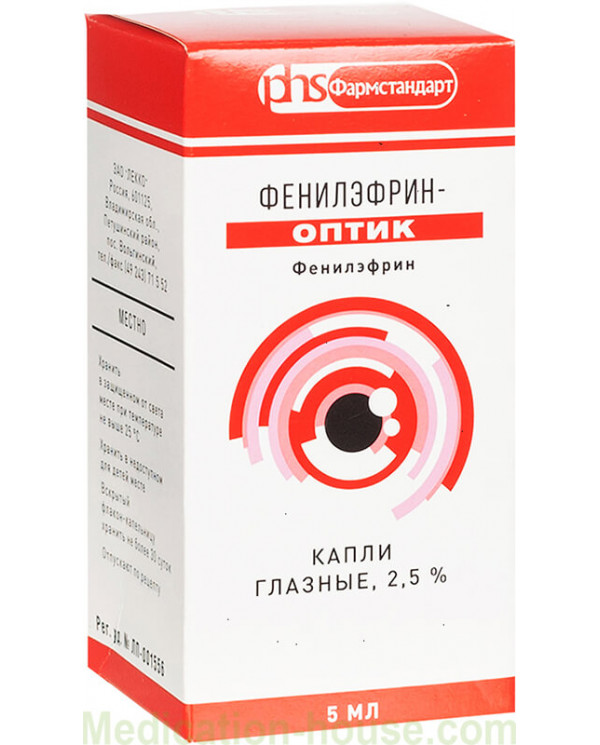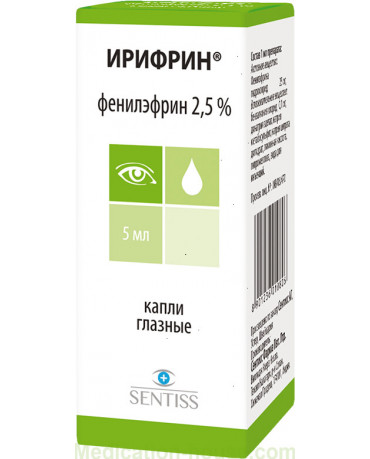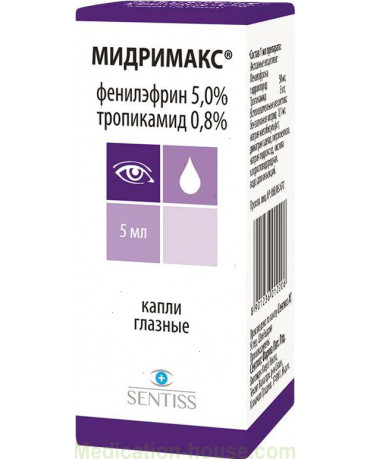Phenylephrine instruction for use
Reed more and buy Phenylephrine on this page
Composition and form of release
The main active ingredient in the drops is the chemical compound phenylephrine hydrochloride, which dissolves well in distilled water. Among the auxiliary components responsible for the uniformity of the structure:
sodium hydroxide;
sodium disulfate;
benzalkonium chloride.
Drops are available in different concentrations of 2.5% and 10%, they can acquire a light yellow or brown tint. The drug is packaged in translucent vials of 5 ml, made of soft plastic, has a convenient dispenser for use.
The drug is used in different concentrations: 2.5% and 10%. Dosages have different indications for use, the duration of the therapeutic effect, therefore, before purchasing drops, it is necessary to discuss the appointment with a doctor.
Therapeutic effect
Phenylephrine eye drops belong to the group of adrenergic agonists. When instilled, they act directly on the nerve endings and α-receptors in the cornea. In response, there is a narrowing of blood vessels, an increase in intraocular pressure. At the same time, the changes occur gradually without sharp jumps, so they do not cause discomfort.
Among the therapeutic actions of Phenylephrine drops:
reduction of burning and itching;
removal of edema;
normalization of the lacrimal canal;
reducing pain with inflammation.
When instilled in the eyes, phenylephrine hydrochloride can normalize intraocular pressure in glaucoma. Pupil dilation occurs: this phenomenon in ophthalmology is called "mydriasis".
The effect lasts from 2 to 7 hours, allowing for a comprehensive examination or treatment. Additionally, the tone of the capillaries increases, which stimulates the flow of oxygen, blood and nutrients to the tissues, improves their condition.
The active substances in Phenylephrine drops penetrate into the bloodstream of the body. They are gradually concentrated in the human liver, where they are purified and metabolized. The medicine is completely excreted by the intestines after 12-24 hours.
Indications and contraindications
Phenylephrine eye drops at a concentration of 2.5% are used in the following situations:
reduction of puffiness of the iris of the eyes with inflammation;
preparation for the ophthalmoscopy procedure;
before carrying out diagnostic measures for suspected glaucoma (test provocation);
reduction of dry eye syndrome.
When instilled into the eyes, Phenylephrine drops at a concentration of 10% give an anti-inflammatory and decongestant effect. They can be used as an independent drug or supplement complex treatment for the following conditions:
preparation for surgery on the lens or iris of the eye;
laser vision correction;
removal of an acute crisis in glaucoma with normalization of intraocular pressure.
Drops with a concentration of 10% should not be used to relieve discomfort during prolonged work at the computer. It dilates the pupil, allowing for an examination of the fundus, reduces painful symptoms in iridocyclitis. Children, when preparing for surgery, use a solution of this dosage only from 8-10 years old.
Phenylephrine eye drops affect the tone of the blood vessels, freely penetrate the tissues, stimulating the work of receptors. Therefore, the following pathologies are contraindications for use:
narrow-angle glaucoma;
violation of the production of phosphate hydrase;
with open eye surgery;
dysfunction of the lacrimal gland;
renal porphyria;
aneurysm of large arteries;
hypothyroidism.
Phenylephrine eye drops are not used in the treatment of patients with chronic diseases of the cardiovascular system with liver and kidney pathologies.
It is not recommended for use in hypertension of any stage: the active substance can provoke a sharp jump in blood pressure. For the same purpose, it is prohibited for patients after a stroke who have signs of cerebrovascular accident.
Instructions and dosage
If it is necessary to carry out diagnostics, eye drops with phenylephrine with a concentration of 2.5% of the active substance are used. 30-40 minutes before the procedure, they should be carefully instilled into the conjunctival sac, slightly lifting the lower eyelid with your finger. The optimal dose is no more than 1-2 drops. After the procedure, you need to close your eyes for 20–30 seconds, massage the corners: this way the composition is better distributed over the cornea and penetrates the tissues faster.
The instructions for use contain the following recommendations:
In the complex treatment of iridocyclitis of inflamed eyes, it is necessary to instill the solution 2-3 times daily, 1-2 drops.
In case of a glaucomatous crisis, a composition of 10% concentration is used 2–3 times a day at the rate of 1 drop per eye.
Before eye surgery, 10% is applied 30 minutes before the procedure.
The maximum concentration of the active substance is observed after 2 hours. With correct application and adherence to the recommended dose, after 6 hours the pupil returns to its normal state and size.
Overdose
Drops of Phenylephrine must be used strictly according to the instructions, adhere to the recommendations of the ophthalmologist. Overdose is more common when using a drug with a concentration of 10%. It is defined by the following symptoms:
strong heartbeat;
blood pressure surges;
muscle weakness;
tachycardia or arrhythmia.
If an overdose of the drug is suspected, the patient must be taken to the hospital. Under the supervision of doctors, he is injected with a solution based on adrenergic receptor blockers. If there is a risk to life, medications that normalize the heart rate are used.
Side effects
When using Phenylephrine drops, local negative reactions may occur, indicating an intolerance to the components:
burning of the mucous membrane;
feeling of "sand" in the eyes;
blurred vision;
copious flow of tears.
More dangerous reactions are observed when the drug acts on the nervous and circulatory system: tremors of the extremities, tachycardia, increased blood pressure, dizziness.
Interaction with other drugs
Before using Phenylephrine drops, you must carefully read the instructions. She indicates incompatibility with certain medications:
many antidepressants;
inhibitors;
cardiac glycosides.
If an operation is to be performed and an ophthalmic solution is required, doctors recommend taking a break of at least 21 days. During this time, the active substance is completely removed from the body, so the risk of getting side reactions and allergies is minimized.
Ophthalmic solution is not used to treat people who are constantly taking hormones to improve their thyroid function. It can block the action of antihypertensive drugs, causing blood pressure problems, impaired blood supply, and shortness of breath.
Reviews
Elena, 32 years old
I constantly work at the monitor, so I began to notice that my vision is falling, the proteins are red and inflamed, and I suffer from dryness and discomfort. The ophthalmologist recommended a course of Phenylephrine Optic drops for 3 weeks. I dripped my eyes before going to bed 1 time, which is very convenient for my work. Among the disadvantages is a slight burning sensation that lasts 5-6 minutes. A small child is unlikely to withstand such a procedure. But the result was very satisfactory to me, so the review of the medicine is positive.
Victor, 27 years old
After a trip to nature, I developed conjunctivitis. I delayed the treatment, so the disease became severe. The doctor prescribed several drugs, among which there were drops of Phenylephrine. I used it before bed, but this is good: the medicine stung my eyes, so I had to keep them closed for a long time. I noticed improvements after a few days, redness and swelling disappeared, vision became clearer. The result has been achieved, so I recommend the medicine.
Terms of sell
You can buy Phenylephrine without a prescription.



